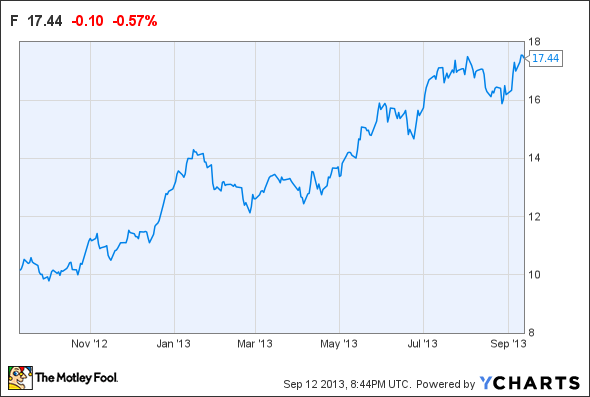One of the most important long-term growth drivers for Ford Motor Company (NYSE:F) is the Chinese market, which is already the largest auto market in the world. Strong sales gains there have played a big role in Ford Motor Company (NYSE:F) stock’s gains over the last year.

Ford 1 Year Stock Chart, data by YCharts
Ford and General Motors have both benefited in China from a territorial dispute between China and Japan. The dispute led to a nationalist backlash against Japanese automakers beginning last August and created a big opportunity for non-Japanese auto brands. As a result, Ford Motor Company (NYSE:F) saw strong sales gains in China during the past few months of 2012. Ford’s China sales are also up an impressive 50% year to date.
However, as Ford Motor Company (NYSE:F) begins to overlap the late 2012 period when anti-Japanese protests peaked, the company will face increasingly tough sales comparisons. On the other hand, Ford is introducing a variety of new models in China to bolster sales. The next few months will therefore be critical for Ford in China. The company will need to get strong performances from its new models to maintain a solid growth rate in the face of tougher comparisons.
Seizing opportunity
Japanese automakers including Toyota Motor Corporation (ADR) (NYSE:TM), Nissan, and Honda Motor Co Ltd (ADR) (NYSE:HMC) have historically been major players in the Chinese auto market. Yet after the eruption of protests last year, Japanese automakers saw their market share plummet from 20.9% last August to just 9.1% in October.
Ford Motor Company (NYSE:F) jumped on this opportunity admirably. In July 2012, Ford Motor Company (NYSE:F) sold 42,560 vehicles, good for a 32% year-over-year increase. Sales ticked up slightly in August, but Ford then set monthly sales records in each of the last four months of the year, reaching a high of 70,510 vehicles sold in December. Year-over-year sales gains averaged around 50% over that time period.

Ford sales in China have exploded in the past year. Photo: The Motley Fool.
However, while Ford has continued to demonstrate strong year-over-year sales growth in 2013, it isn’t seeing the same level of sequential growth. In fact, the 2013 sales pace has averaged just under 69,000 vehiclesa month — less than Ford’s December 2012 sales total. At the same time, Japanese automakers have gradually made up ground. In fact, Toyota Motor Corporation (ADR) (NYSE:TM) now expects 2013 sales in China to be about 7% higher than its 2012 total.
In other words, Japanese automakers seem to be regaining their stride in China at the same time Ford will face much tougher year-over-year comparisons. Will these headwinds undermine Ford’s growth trajectory in China?
Staying strong
Ford’s 50% growth year-to-date puts the company in good position to meet its target of doubling sales in China by 2015. However, slower growth is almost inevitable over the next few months because of the resurgence of Japanese competition.
Fortunately, Ford Motor Company (NYSE:F) is aggressively introducing new models in China to address more segments of the market. Late last month, Ford began selling the Mondeo, a midsize car similar to the popular North American Ford Fusion. Ford has also launched three new SUVs in China this year to meet surging demand for that vehicle type. The early sales data for these new models is encouraging.
Even if Japanese automakers manage to claw back some market share in the compact segment — the Ford Focus has accounted for nearly half of Ford’s unit sales in China this year — Ford’s entry into other market segments should keep growth in the double digits.
That’s obviously not as good as the 50% growth Ford has enjoyed recently. However, it should still be enough for Ford to continue gaining market share. In the long run, Ford’s powerful brand and proven strategy should allow it to capture its fair share of the critical China market.
The article Crunch Time for Ford in China originally appeared on Fool.com and is written by Adam Levine-Weinberg.
Fool contributor Adam Levine-Weinberg has no position in any stocks mentioned. The Motley Fool recommends Ford and General Motors and owns shares of Ford.
Copyright © 1995 – 2013 The Motley Fool, LLC. All rights reserved. The Motley Fool has a disclosure policy.




